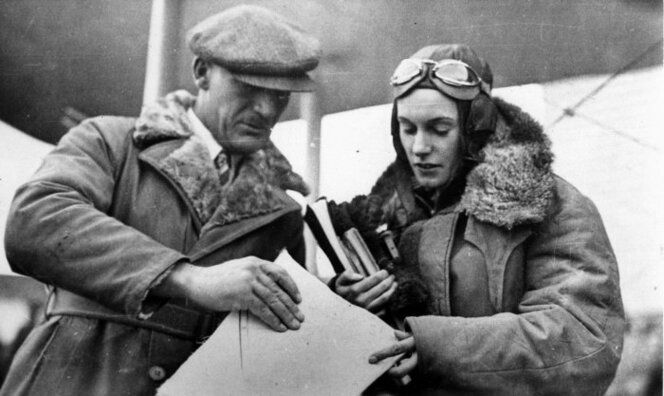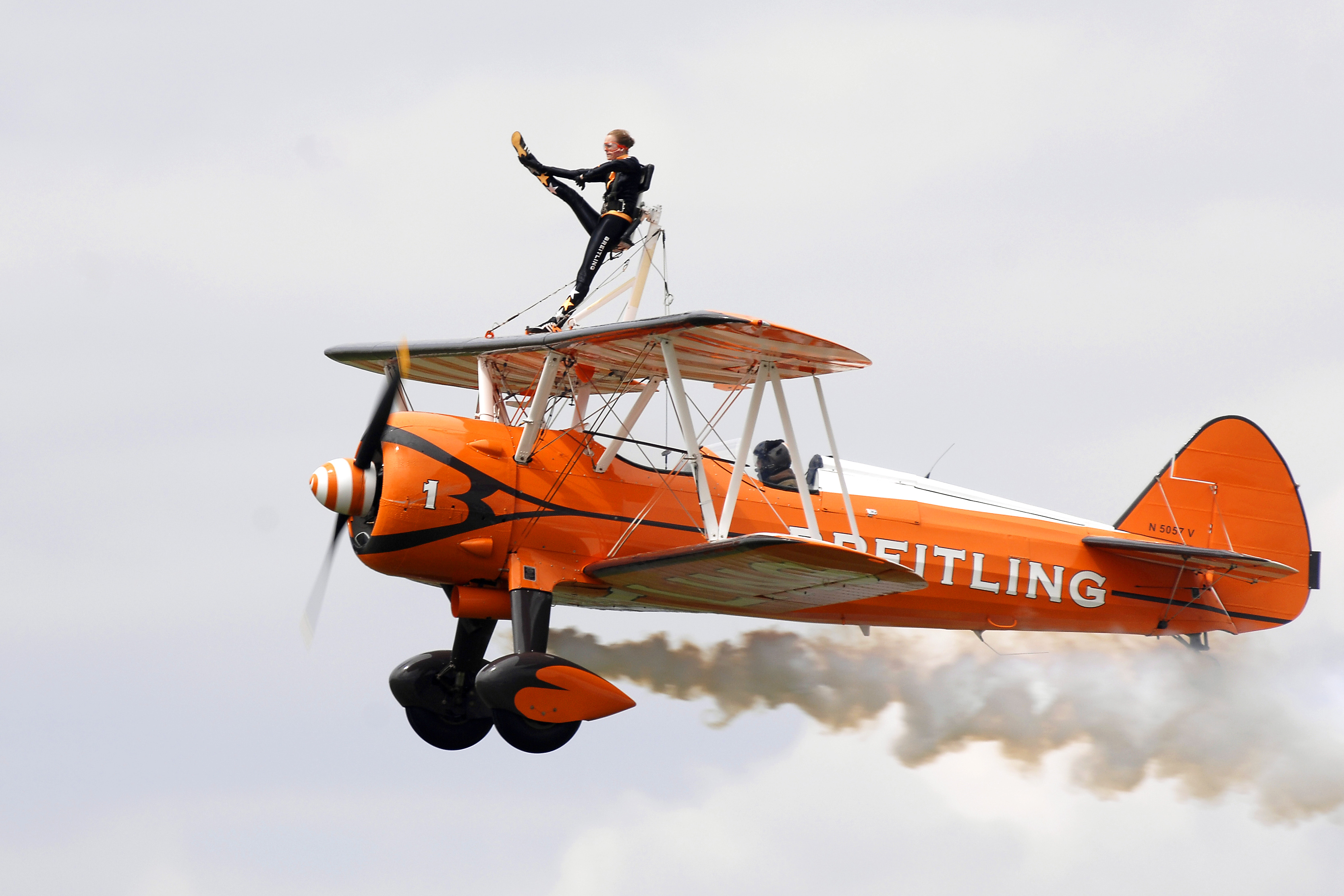|
Malcolm C. McGregor
Captain Malcolm Charles McGregor (4 March 1896 – 19 February 1936) was a New Zealand born World War I flying ace. He was credited with 11 victories during the war. Postwar, he was an aviation pioneer in his home country, a competitor in intercontinental air racing and held the rank of squadron leader in the New Zealand Territorial Air Force. Appointed a director, technical adviser and service manager for the new national airline, Union Airways which became NAC, he died in Wellington Hospital following a flying accident in a company aircraft just before his 40th birthday. Early life Malcolm Charles McGregor was born near Hunterville, New Zealand on 4 March 1896 son of Ewen McGregor and his wife born Matilda Chubbin. He was educated at Hamilton Boys' High School. When grown, he was six feet three inches tall. World War I MacGregor was granted his Aero Certificate in September 1916. On 7 April 1917, McGregor was appointed a Flying Officer in the Royal Flying Corps. His first ... [...More Info...] [...Related Items...] OR: [Wikipedia] [Google] [Baidu] |
Hunterville
Hunterville is a small community on State Highway 1, in the Rangitikei district of the North Island of New Zealand. It is located halfway between Taupo and Wellington and has a population (2018 census) of 411, a decrease of 18 people from 2013. The township was named for George Hunter, who was a member of the Wellington Provincial Council. It straddles the state highway as well as the main trunk railway in the foothills forming the gateway to the Central Plateau. Kiwiburn, the New Zealand Burning Man regional burn, has been held there since 2014. The closest airport or airfield to Hunterville is RNZAF Base Ohakea, an important Royal New Zealand Air Force base, which is sited 33 km to the south west. 6 km north of Hunterville is Vinegar Hill. The Hunterville railway station on the North Island Main Trunk line opened in 1887 and closed in 1988. Hunterville is well known for its statue of the huntaway, a specialised herding dog that uses its voice to drive the sh ... [...More Info...] [...Related Items...] OR: [Wikipedia] [Google] [Baidu] |
Pfalz D
Pfalz, Pfälzer, or Pfälzisch are German words referring to Palatinate. They may refer to: Places *Pfalz, the Palatinate (region) of Germany **Nordpfalz, the North Palatinate **Vorderpfalz, the Anterior Palatinate **Südpfalz, the South Palatinate **Westpfalz, the West Palatinate *Pfalz, the Palatinate wine region of Germany **Pfälzische Weinkönigin, the Palatine Wine Queen elected representative of the region *the ''Pfalz'', nickname for Pfalzgrafenstein Castle, Germany *Pfälzerwald, the Palatinate Forest *Rheinland-Pfalz, the current federal German state of Rhineland-Palatinate Historic states *''Kurpfalz'', the Electoral Palatinate of the Holy Roman Empire. Historic houses and states include: **Pfalz-Birkenfeld, the House of Palatinate-Birkenfeld ** Pfalz-Birkenfeld-Bischweiler ** Pfalz-Birkenfeld-Gelnhausen ** Pfalz-Birkenfeld-Zweibrücken **Pfalz-Kleeburg ** Pfalz-Landsberg ** Pfalz-Lautern ** Pfalz-Mosbach ** Pfalz-Mosbach-Neumarkt ** Pfalz-Neuburg **Pfalz- ... [...More Info...] [...Related Items...] OR: [Wikipedia] [Google] [Baidu] |
The Great Depression
The Great Depression (19291939) was an economic shock that impacted most countries across the world. It was a period of economic depression that became evident after a major fall in stock prices in the United States. The economic contagion began around September and led to the Wall Street stock market crash of October 24 (Black Thursday). It was the longest, deepest, and most widespread depression of the 20th century. Between 1929 and 1932, worldwide gross domestic product (GDP) fell by an estimated 15%. By comparison, worldwide GDP fell by less than 1% from 2008 to 2009 during the Great Recession. Some economies started to recover by the mid-1930s. However, in many countries, the negative effects of the Great Depression lasted until the beginning of World War II. Devastating effects were seen in both rich and poor countries with falling personal income, prices, tax revenues, and profits. International trade fell by more than 50%, unemployment in the U.S. rose to 23% an ... [...More Info...] [...Related Items...] OR: [Wikipedia] [Google] [Baidu] |
Miles M-3B Falcon Major ZK-AEI
The mile, sometimes the international mile or statute mile to distinguish it from other miles, is a British imperial unit and United States customary unit of distance; both are based on the older English unit of length equal to 5,280 English feet, or 1,760 yards. The statute mile was standardised between the British Commonwealth and the United States by an international agreement in 1959, when it was formally redefined with respect to SI units as exactly . With qualifiers, ''mile'' is also used to describe or translate a wide range of units derived from or roughly equivalent to the Roman mile, such as the nautical mile (now exactly), the Italian mile (roughly ), and the Chinese mile (now exactly). The Romans divided their mile into 5,000 Roman feet but the greater importance of furlongs in Elizabethan-era England meant that the statute mile was made equivalent to or in 1593. This form of the mile then spread across the British Empire, some successor states of which conti ... [...More Info...] [...Related Items...] OR: [Wikipedia] [Google] [Baidu] |
Batten With McGregor, 1936
A batten is most commonly a strip of solid material, historically wood but can also be of plastic, metal, or fiberglass. Battens are variously used in construction, sailing, and other fields. In the lighting industry, battens refer to linear light fittings. In the steel industry, battens used as furring may also be referred to as "top hats", in reference to the profile of the metal. Roofing ''Roofing battens'' or ''battening'', also called ''roofing lath'', are used to provide the fixing point for roofing materials such as shingles or tiles. The spacing of the battens on the trusses or rafters depend on the type of roofing material and are applied horizontally like purlins. Battens are also used in metal roofing to secure the sheets called a ''batten-seam roof'' and are covered with a ''batten roll joint''. Some roofs may use a grid of battens in both directions, known as a ''counter-batten system'', which improves ventilation. Roofing battens are most commonly made of ... [...More Info...] [...Related Items...] OR: [Wikipedia] [Google] [Baidu] |
De Havilland Gipsy Moth
The de Havilland DH.60 Moth is a 1920s British two-seat touring and training aircraft that was developed into a series of aircraft by the de Havilland Aircraft Company. Development The DH.60 was developed from the larger DH.51 biplane. The first flight of the ADC Cirrus powered prototype DH.60 Moth (registration ''G-EBKT'') was carried out by Geoffrey de Havilland at the works airfield at Stag Lane on 22 February 1925. The Moth was a two-seat biplane of wooden construction, it had a plywood covered fuselage and fabric covered surfaces, a standard tailplane with a single tailplane and fin. A useful feature of the design was its folding wings which allowed owners to hangar the aircraft in much smaller spaces. The then Secretary of State for Air Sir Samuel Hoare became interested in the aircraft and the Air Ministry subsidised five flying clubs and equipped them with Moths. The prototype was modified with a horn-balanced rudder, as used on the production aircraft, and wa ... [...More Info...] [...Related Items...] OR: [Wikipedia] [Google] [Baidu] |
Barnstorming
Barnstorming was a form of entertainment in which stunt pilots performed tricks individually or in groups that were called flying circuses. Devised to "impress people with the skill of pilots and the sturdiness of planes," it became popular in the United States during the Roaring Twenties. Barnstormers were pilots who flew throughout the country to sell airplane rides and perform stunts. Charles Lindbergh first began flying as a barnstormer. Barnstorming was the first major form of civil aviation in the history of aviation. History Background The Wright brothers and Glenn Curtiss had early flying exhibition teams, with solo flyers like Lincoln Beachey and Didier Masson also popular before World War I, but barnstorming did not become a formal phenomenon until the 1920s. The first barnstormer, taught to fly by Curtiss in 1909, was one Charles Foster Willard, who is also credited as the first to be shot down in an airplane when an annoyed farmer broke his propeller firing ... [...More Info...] [...Related Items...] OR: [Wikipedia] [Google] [Baidu] |
King's Birthday Honours
The Birthday Honours, in some Commonwealth realms, mark the reigning British monarch's official birthday by granting various individuals appointment into national or dynastic orders or the award of decorations and medals. The honours are presented by the monarch or a viceregal representative. The Birthday Honours are one of two annual honours lists, along with the New Year Honours. All royal honours are published in the relevant gazette. History Honours have been awarded with few exceptions on the sovereign's birthday since at least 1860, during the reign of Queen Victoria. There was no Birthday Honours list issued in 1876, which brought "a good deal of disappointment" and even rebuke for the Ministry of Defence. A lengthy article in the ''Broad Arrow'' newspaper forgave the Queen and criticised Gathorne Hardy for neglecting to award worthy soldiers with the Order of the Bath: "With the War Minister all general patronage of this description rests, and if Mr. Hardy has not seen f ... [...More Info...] [...Related Items...] OR: [Wikipedia] [Google] [Baidu] |
Maretz
Maretz is a commune in the Nord department in northern France. It is 22 km south east of Cambrai. As of 2019, the population is 1,444. Heraldry See also *Communes of the Nord department The following is a list of the 648 communes of the Nord department of the French Republic. The communes cooperate in the following intercommunalities (as of 2020):Communes of Nord (French department) {{Nord-geo-stub ... [...More Info...] [...Related Items...] OR: [Wikipedia] [Google] [Baidu] |
Observation Balloon
An observation balloon is a type of balloon that is employed as an aerial platform for intelligence gathering and artillery spotting. Use of observation balloons began during the French Revolutionary Wars, reaching their zenith during World War I, and they continue in limited use today. Synonyms include espionage balloon, reconnaissance balloon, or surveillance balloon. Historically, observation balloons were filled with hydrogen. The balloons were fabric envelopes filled with hydrogen gas, whose flammable nature led to the destruction of hundreds of balloons on both sides. Observers manning these observation balloons frequently had to use a parachute to evacuate their balloon when it came under attack. To avoid the potentially flammable consequences of hydrogen, observation balloons after World War I were often filled with non-flammable helium. Typically, balloons were tethered to a steel cable attached to a winch that reeled the gasbag to its desired height (usually 1,000-1,5 ... [...More Info...] [...Related Items...] OR: [Wikipedia] [Google] [Baidu] |
Balloon Buster
Balloon busters were military pilots known for destroying enemy observation balloons. These pilots were noted for their fearlessness, as balloons were stationary targets able to receive heavy defenses, from the ground and the air. Seventy-seven flying aces in World War I were each credited with destroying five or more balloons, and thus were balloon aces. The crucial role of observation balloons An observation balloon was both a vulnerable and a valuable target: the balloon was moored in a stationary position and was lifted by flammable hydrogen gas, whose use was necessitated by the scarcity of helium reserves among European powers. The artillery observer, suspended in the wicker basket beneath, typically had a wireless transmitter, binoculars and/or a long-range camera. His job was to observe actions on the front-line and behind it, to spot enemy troop movements or unusual activity of any sort, and to call down artillery fire onto any worthwhile targets. Balloon observers we ... [...More Info...] [...Related Items...] OR: [Wikipedia] [Google] [Baidu] |

.jpg)





